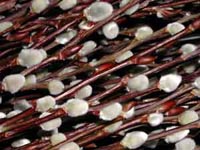Resource Library
Plant of the Week: Willow, Pussy
The University of Arkansas System Division of Agriculture does not promote, support or recommend plants featured in "Plant of the Week." Please consult your local Extension office for plants suitable for your region.
Plant of the Week
Pussy Willow
Latin: Salix caprea

Each year at the Arkansas Flower and Garden Show in Little Rock there seems to be a must-have item that the attendees magically select from the profusion of assembled items. This year the pussy willow seemed to get the nod and gardeners could be seen strolling through the show peering through a bundle of brush like a duck hunter secreted in a blind. If husbands were the designated brush carrier, the stroll was often accompanied with a bit of grumbling.
Pussy willow is a collective name used to describe the willows that produce soft, fuzzy buds up and down the shiny bare twigs in late winter. While the name is used for about six different species, the most commonly grown pussy willow is Salix caprea, known by the common names of French Pussy Willow or Goat Willow.
This European pussy willow is a small, deciduous, much-branched tree that grows to 20 feet tall with an oval form. It’s four inch long leaves are broadly elliptical in outline and nearly toothless with the upper surface deep green, the lower a soft gray-green. The leaves often take on tattered appearance by fall when the tree will occasionally produce a modest yellow fall color display.
In late February or early March the buds of pussy willow awaken from their winter rest and expand, popping off their mahogany colored bud scales to reveal the fuzz beneath. This is the stage when the stems are cut for the florist trade, freezing the buds in this half-awakened state. But if the plant is grown in the garden, these buds continue to expand and form inch and a half long gray, fuzzy catkins that look like a wooly caterpillars. On male plants these catkins produce yellow anthers which provide the bee keeper a source of pollen in early spring and the observant gardener a subtle beauty when viewed close at hand.
Willows were the first tree intentionally planted for harvest in a forest-like setting. Foresters must shutter to think of the fast growing, weak-wooded willow as the antecedent of their industry, but it has none-the-less been planted since before the middle ages in stands called coppices. Frequent harvests, yearly if lithe twigs were needed for basketry or every five years if poles were needed, renewed the coppice and kept it vigorous.
Pussy willow is a worthwhile addition to the garden, but in its unadulterated form it grows too large and is not showy enough for the space it will take. The solution to this problem is to use the pruning technique called stooling. In stooling you prune until you think you’ve killed it and then prune some more. Stooled plants are cut back to within a foot of the ground each spring just after flowering but before new growth starts. This keeps their size down and produces long stems with the fuzzy buds for future flower arrangements.
Pussy willow is not particular about growing conditions, but it does require full sun. It performs best in a fertile soil of good tilth but will tolerate less desirable locations. Willows do not require moist soils, but simply grow along waterways because that provides them the light they need. New plants can be easily started by cutting a fresh, foot long, leafless branch in late winter. Stick this into the soil so that only about three inches remains above ground. Keep this watered until new roots form. In a wonderful display of synchronicity leaves appear as the roots begin growing.
By: Gerald Klingaman, retired
Extension Horticulturist - Ornamentals
Extension News - April 12, 2002
The University of Arkansas System Division of Agriculture does not maintain lists of retail outlets where these plants can be purchased. Please check your local nursery or other retail outlets to ask about the availability of these plants for your growing area.